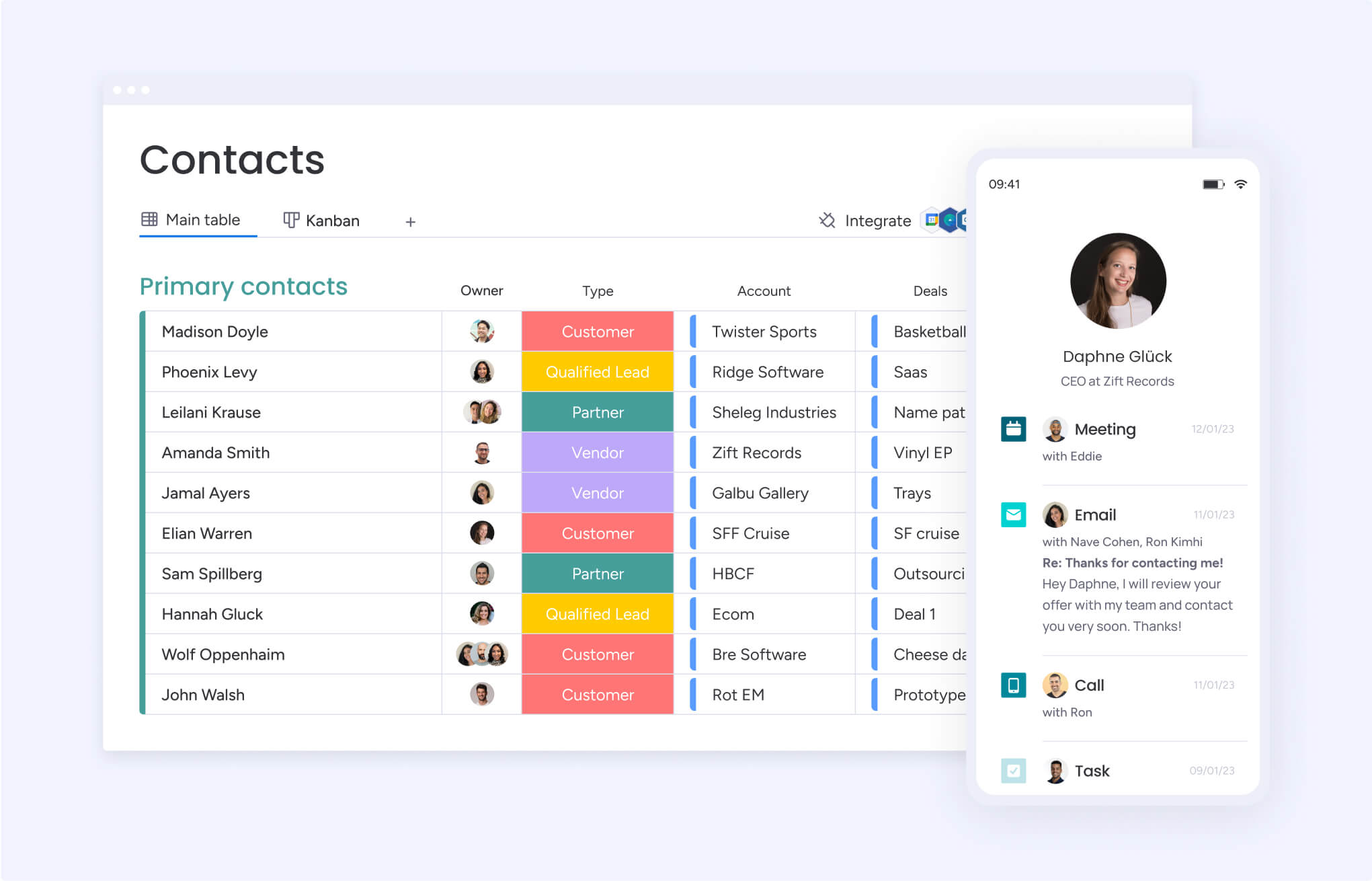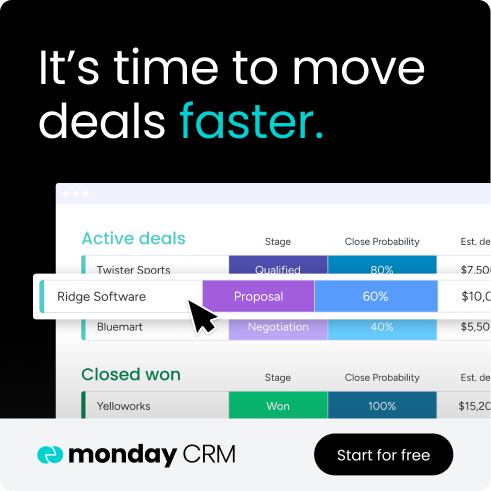You may have a regular habit of grabbing a coffee from your favorite coffee shop, but in all likelihood, you probably don’t think about the transaction and its paperwork after tapping your card and walking away. Most of the time, you’ll either crumple up the receipt and throw it away or not even take it at all.
While this works for coffee purchases, business transactions couldn’t be more different. The paperwork involved in completing a sale, like a sales invoice and receipt, are essential documents for your business’s accounting.
In this blog post, we’ll take a closer look at sales invoices, why they’re so important, what you should include on each one, and best practices. We’ll also examine how a platform like monday CRM can complement your sales invoice processes with additional features and functionalities.
Try monday CRMWhat is a sales invoice?
A sales invoice is an official accounting document. It’s used by businesses to record sales transactions and send payment requests for goods sold or services provided.
On a sales invoice, you’ll typically find important business data such as transaction dates, taxes, discounts issued, payment amounts, and more. It may also inform a customer how they can make their payment and payment terms such as installments.
Sales invoices are legally binding contracts between a company and a customer.
They serve as a way to track sales and payments for purchases of all sizes. Essentially, even if you shake hands on a closed deal, you need to issue an accurate sales invoice to receive payment from a customer.
Why are sales invoices important?
Sales invoices are important because they support accurate inventory management, help you organize your bookkeeping and accounting, and create a log for business analytics. Let’s take a look at these benefits in more detail.
1. Support accurate inventory management
If your company sells physical products, unchecked inventory distortion is likely costing you a lot of money in lost potential revenue, with some estimates suggesting retailers worldwide lose more than $818 billion annually.
Sales invoices can help you keep track of the goods sold and therefore help you reduce inventory distortion. When sales invoices are integrated with systems like a CRM or inventory management tool, operations can be automated so that inventory is instantly removed from inventory when a sales invoice is issued.
2. Organize bookkeeping and accounting
Every business owner needs to have proper bookkeeping and accounting systems in place. Failure to do so can lead to legal and accounting issues.
Sales invoices are a crucial component of these systems because they create a record of goods sold and services provided. Having these records available will help protect your company in case of a legal dispute with a customer.
3. Tax return resources and legal protection
When you have accurate sales invoices that are well-documented and organized, your tax return season will be a lot easier. Sales invoices are essential for verifying claims on tax returns and can be requested in the event your business is audited.
Additionally, if you decide to sell your business in the future, go public, or merge, potential partners or buyers are likely to request access to your financial records including sales invoices. Implementing a platform like monday CRM can make keeping track of these documents easier and more intuitive.
Try monday CRM4. Create a log for business analytics
Sales invoices make up an important part of your business data. This type of data offers insights into financial patterns and helps you identify best-selling products, most valuable customers, and more.
With this information, you can make data-driven decisions and develop winning strategies for your business. You can also create more exact budgets that are based on accurate numbers, assess where customers are in your sales funnel, predict future cash flow, and better plan for essential business spending.
Key elements to include in every sales invoice
Sales invoices can be customized and often vary from business to business depending on what businesses sell, their unique payment terms, and other factors. However, there are certain components that should be included on most invoices. Here’s a look at the key elements to include:
Contact information
Include the names, addresses, and contact details like phone numbers and emails for both your business and the customer. You may also want to address the invoice to a specific person if your customer is a company. This will ensure your invoice is directed to the right person or department so there are no payment delays.
Date of issue
Display the date on which your sales invoice was issued and sent. This is important because the date becomes the start of your transaction and may need to be taken into consideration with your payment terms if the client incurs late fees. It also helps you organize your sales invoices and accounting by sorting them by date.
Invoice number
Every sales invoice must include a sequential unique invoice number. They are usually placed at the top of the invoice and ensure payments are tracked for accounting purposes. Invoice numbers usually follow a sequence and make the document easier to track for both the issuer and recipient.
Payment terms
Payment terms can include different information, such as the deadline when the customer needs to pay (such as “payment due in 30 days”), methods of payment, or terms like whether the payment is being made in installments. Ideally, expectations on payment terms are set when closing a deal, but including it on a sales invoice serves as a formal reminder and makes it legally binding.
Products sold and services rendered
Include an itemized list of products sold and services rendered. Make sure to also note the quantity and unit price of each and divide the information into columns to make it clear. Noting all the goods and services on a sales invoice will help you avoid payment disputes.
Amount due
The total amount due including applicable taxes, discounts, and prepaid deposits should always be clearly stated on an invoice. The subtotal and total is likely the first piece of information a recipient will look for, so it’s important to make sure it’s obviously stated on an invoice to speed up the transaction.
Tips and best practices for sending sales invoices

The purpose of sending a sales invoice is to get paid for goods or services rendered. However, as a business, every client interaction matters, and sending invoices is no exception. Below, you’ll find some important tips and best practices for sending sales invoices to ensure you’re paid on time and that you’re improving customer relationships with every interaction.
1. Make sure your invoice is clearly labeled
There are different types of documents you may need to send clients, like quotes, sales orders, or receipts, and all of them may look similar. To prevent confusion or invoices being lost in the shuffle, ensure you have a noticeable “invoice” label at the top of your document and title the file as such if you’re sending it by email.
2. Create a personalized experience
Sending financial documentation is usually a dry experience, but you can spruce it up by personalizing the interaction. Send a personalized message, add the recipient’s name, or offer to be available to answer questions about the invoice. Use a CRM to automate and tailor these emails so they become communications that continue to foster a solid relationship and positive customer experience.
3. Offer different payment options
Make sure your invoice or accompanying message clearly states all the relevant ways a recipient can pay and instructions or links on how to complete payment. This will help avoid questions or delays in receiving payment and allow customers to choose a method that fits their needs.
4. Ensure you’re sending the invoice to the right person
When working with other businesses and sending a new customer their first invoice, it’s important to ask who to direct invoices to. This may be a specific department or contact, but getting all their contact information such as email, full name, and phone number can help you ensure the invoice is going to the right place so that you avoid payment delays and know exactly who to follow up with.
5. Automate reminders
Not all clients will pay on time. Some may need to pay according to their accounting department’s payment cycle, or others may simply be juggling a lot and forget. Use accounting software or a CRM to set up automatic emails after you send out a sales invoice so that customers are gently reminded that they still have an outstanding invoice. You can set this up easily on platforms like monday CRM in just a few minutes.
Try monday CRMOptimize sales invoice processes with monday CRM
Using a CRM allows your business to not only send out invoices in an organized way but can also complement the process with additional features. Platforms like monday CRM allow you to store client information on one unified platform, making it easier to send communications, documents, and personalize the customer experience.
In addition, monday CRM helps companies foster stronger communication organization-wide. Other departments such as marketing or customer service can use the same platform to collaborate on projects or share important customer information and insights.
monday CRM is designed to give you visibility into any sales process and optimize the way your team works, saving you time and creating a more positive impact on client interactions. Here are a few key monday CRM features that will allow you to optimize your sales invoice processes.
Automate reminders and notifications

monday CRM uses no-code automation so that you can create workflows to enhance the sales invoice experience. Create customized communications to send invoices and payment reminders, set notifications to remind team members to follow up, auto-generate sales reports, or trigger a notification when there’s an update on an invoice.
Integrate with popular accounting software
monday CRM integrates with over 200 of the most popular work apps, allowing you to seamlessly work between programs and collect important information in one place. With monday CRM, you can integrate with apps like QuickBooks, GetSign, Cash Flow, as well as apps for currency conversion.
Generate advanced sales reports

With monday CRM, you can instantly generate automated reports to gather insights on your sales invoice processes. This will give you deeper insights into your most valuable clients, which clients pay on time and which need longer, outstanding invoices, team sales performance, your sales pipeline from closing a deal to receiving payment, and more.
Try monday CRMStreamline invoicing for smoother payments
Sales invoices are important when it comes to managing your inventory, keeping your accounts organized, and generating data for business analytics. Investing in invoicing software like monday CRM helps you streamline the invoicing process by creating an automated sales invoice workflow while also guarding against human error and helping scale your business.
FAQs
Is a sales order the same as an invoice?
No, they are not the same. A sales order is a document that customers send to a business. This document allows them to order the products they want to purchase and prepay for them. A sales invoice, on the other hand, is a document a business sends to customers to request payment for goods after they have already been delivered.
What is the difference between a sales invoice and a sales receipt?
A sales invoice is sent to customers to request payment for the goods sold or services rendered. A sales receipt is a document you send to the customer once you receive their payment to provide proof of receipt of payment.
How long should you keep sales invoices?
The general rule of thumb is to keep your sales invoices for 3-7 years, depending on the type of business you run. Implementing a platform like monday CRM can help you store and organize historical records of invoices so they can be accessed in the event you need them for an audit.

